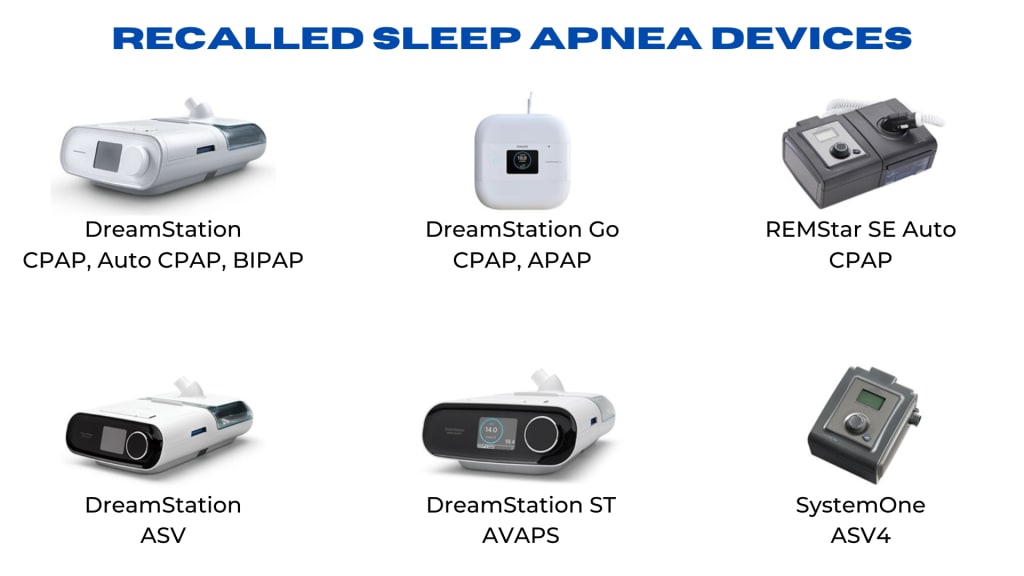Your Sleep Apnea Machine Could Cause Cancer
Philips Recalls its CPAP Devices Warning that they Could be Causing Users to Inhale Carcinogenic Chemicals

Millions of people in the U.S. use a CPAP machine at night for the treatment of sleep apnea. The CPAP machine delivers a continuous stream on inward air pressure through a face mask to prevent the user's airways from closing. CPAP machines are supposed to prevent the various health risks associated with sleep apnea, such as high blood pressure and other cardiovascular problems. But last month the leading manufacturer of CPAP devices, Philips, revealed that its sleep apnea devices may been harming users and exposing them to carcinogenic chemicals.
Philips is a large international medical device company and its Philips Respironics division designs and manufacturers about half of the CPAP and BiPAP sleep apnea devices on the market today. The flagship brand of the Philips sleep apnea devices is the DreamStation line of products.
In April of this year, Philips issued a public announcement warning consumers about a potentially dangerous defect involving the sound abatement foam in the DreamStation and other CPAP devices. The DreamStation uses polyurethane foam called PE-PUR to limit the noise that the machine makes at night. According to Philips, this PE-PUR foam had a tendency to degrade over time and cause users to inhale tiny particles and chemicals during their sleep.
The next month, on June 14, 2021, Philips issued a sweeping safety recall of the DreamStation and nearly all of its other CPAP and BiPAP devices. According to the recall notice, testing and research by Philips found that the PE-PUR foam particles were causing users to inhale very toxic chemicals. Some of the chemicals users were inhaling have been identified as human carcinogens by the CDC. In its 6/14/21 recall notice, Philips described the potential health risks associated with inhaling these chemicals as “serious and potentially life threatening.”
Based on the announcement and information released by Philips, it appears that prolonged inhalation of the sound abatement foam from the recalled sleep apnea devices can cause the following health consequences:
Severe inflammation of the airways (especially in patients with pulmonary conditions)
Pulmonary fibrosis
Chronic sinus infection
Damage to the kidney and liver
Cancer (lung, liver, kidney, and other types of cancer)
List of Recalled Philips Sleep Apnea Devices
The Philips CPAP and BiPAP sleep apnea devices that were subject to the safety recall include the following brands and models:
DreamStation ASV , DreamStation ST, AVAPS , SystemOne ASV4 , C Series ASV, S/T, AVAPS , OmniLab Advanced Plus , DreamStation CPAP, Auto CPAP, BiPAP , DreamStation Go CPAP, APAP , REMStar SE Auto CPAP , Dorma 400, 500 CPAP , SystemOne (Q Series).
In total, the Philips recall covered an estimated 3.5 million devices potentially in use in the U.S. today.
Lawsuits Following the Philips CPAP Recall
The Philips sleep apnea safety recall has already generated 18 CPAP recall lawsuits against Philips in federal courts across the country. The plaintiffs in these CPAP lawsuits are alleging that Philips was well aware of the problems with the PE-PUR foam and its health risks to users long before they issued the recall. In fact, Philips seems to have designed and launched a new, safer alternative line of CPAP machines (without the harmful PE-PUR foam) just before it recalled the older devices. This clearly suggests that Philips was aware of the problems and that it designed a new machine and waited to notify the public until that new machine was on the market.
The other evidence suggesting that Philips had prior knowledge of the problems can be found in the allegations of the CPAP recall lawsuits that have recently been filed. Each of the complaints in these lawsuits makes a specific allegation that Philips had been recieving consumer complaints for years about dust particles being inhaled from the CPAP machines (presumably from the PE-PUR foam).





Comments
There are no comments for this story
Be the first to respond and start the conversation.